
Keep it LOW
Keep it LONG
Keep it SHIELDED
Beachfront artificial lighting poses a serious threat by disorienting the hatchlings, causing them to crawl away from the ocean and toward the artificial light.
There are ways that beachfront property owners can modify their lights to prevent them from being seen from the beach. Multiple solutions may need to be used to prevent sea turtle disorientation.
- Keep it Low: Keep outdoor lighting as low as possible to the ground for the needed purpose.
- Keep it Shielded Materials such as aluminum flashing can be used as a shield to direct light and keep it off the beach. When shielding lights, it is important to make sure they are shielded from all areas on the beach (including from either side and on top), and not just from the beach directly in front of the light. Black oven paint may be used as a temporary solution. Light sockets with an exposed light source (such as plain bulbs) should be replaced with fixtures that are specially made to recess and/or the light source should be shielded.
- Turn Off Unnecessary Lights: Don’t use decorative lighting such as runner lights or up-lighting on vegetation in areas that are visible from the beach. Permanently remove, disable, or turn off fixtures that cannot be modified.
- Choose Turtle-Friendly Fixtures: Replace incandescent, fluorescent, and high-intensity lighting with the lowest wattage/ lumens necessary for the needed purpose.
- Reposition Lights: For lights that can be repositioned, face them away from the beach so that the light source is no longer visible.
- Select lamps/bulbs that produce only long wavelength light (560 nm or greater, which is amber, orange, or red). The best technology available for sea turtle-friendly lighting is a red or amber LED.
- Install Directional Lighting: Replace fixtures that scatter light in all directions (such as globe lights or carriage lights) with directional fixtures that point down and away from the beach.
- Create Natural Barriers: Plant or improve vegetation buffers such as sea grapes and other native beach vegetation between the light source and the beach to prevent light from shining toward the beach.
- Use Motion Detector Lights: Use shielded motion detector lights for lighting and set them on the shortest time setting.
- Manage Indoor Lighting: To reduce spillover from indoor lighting, move light fixtures away from windows, apply window tint to your windows with a 45% inside to outside transmittance standards for tinted glass, and use window treatments like blinds or curtains, to shield interior lights from the beach.

